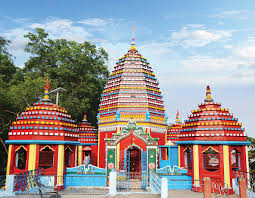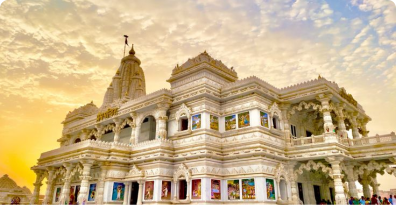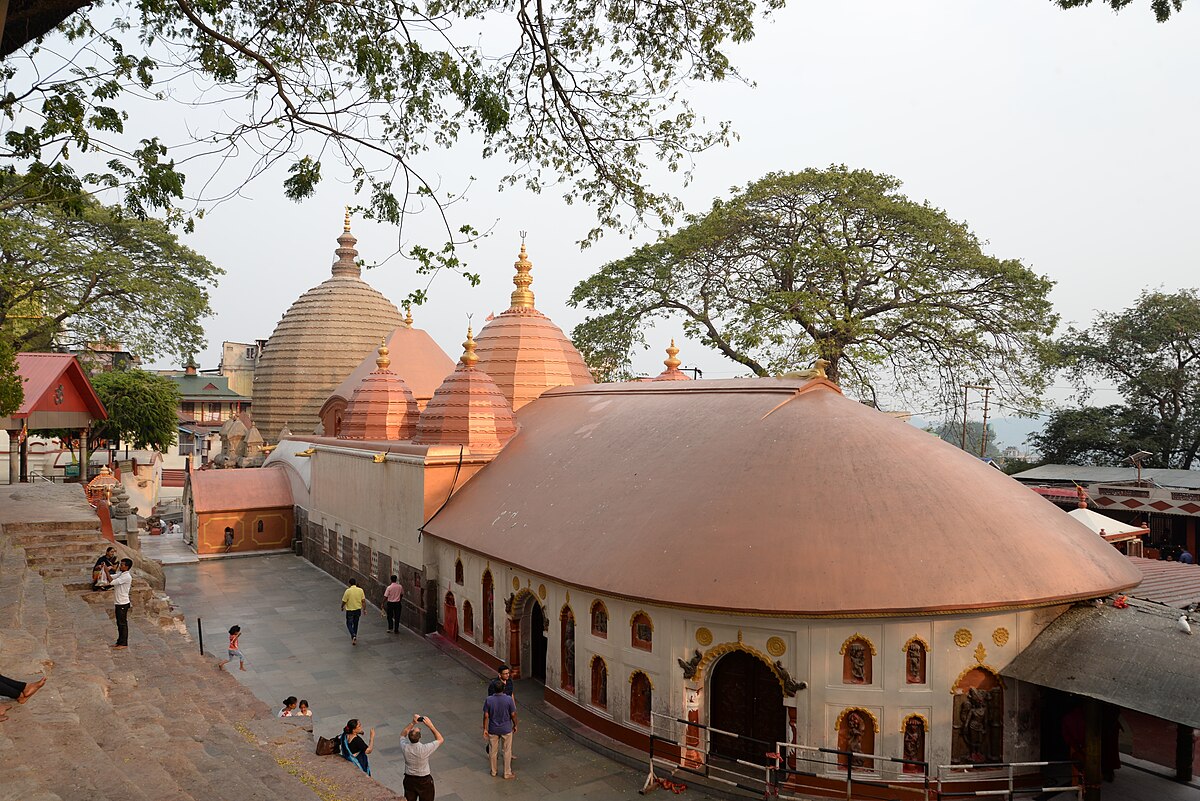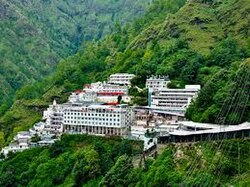
September 30, 2025
Temple Mandir
4 min read
Rajrappa Temple
Tucked away at the confluence of the Damodar and Bhairavi rivers in Jharkhand, the Rajrappa Temple is an ancient Shakti Peetha dedicated to Goddess Chinnamasta — a fierce and unique form of Shakti. Revered for its tantric significance, spiritual power, and natural beauty, this temple is a hidden gem for seekers of divine energy and mysticism.
Rajrappa Temple – The Mystical Seat of Goddess Chinnamasta
Located in Ramgarh district of Jharkhand, the Rajrappa Temple is one of the most unique and powerful temples dedicated to Goddess Chinnamasta, one of the ten Mahavidyas (wisdom goddesses) in Hinduism. The temple is situated at the sacred Sangam (confluence) of the Damodar and Bhairavi rivers, adding to its spiritual and geographical importance.
What sets Rajrappa apart is the unusual and symbolic depiction of the goddess — decapitated, holding her own severed head in one hand, and standing atop two copulating figures. The image is bold, symbolic, and spiritually intense, representing self-sacrifice, transformation, and feminine power beyond fear or limitation.
🕉 The Legend of Goddess Chinnamasta
The name Chinnamasta literally means “She who is severed-headed.” According to the legend, while bathing in a river with her two attendants — Dakini and Varnini — the goddess found them hungry. To feed them, she severed her own head. From her neck, three blood streams emerged — one going into each attendant's mouth, and the third flowing into her own.
This act symbolizes:
Self-sacrifice and compassion
Control over ego and desires
Life, death, and rebirth in a continuous cycle
Worship of Chinnamasta is often associated with Tantric practices, and the temple is considered highly potent for spiritual awakening and energy transformation.
🛕 The Temple Premises and Rituals
The main idol of Chinnamasta is carved on a black stone slab inside the Garbhagriha (sanctum). The goddess is shown standing over Kama (lust) and Rati (desire), signifying the victory of spiritual consciousness over base instincts.
Devotees offer red flowers, sindoor, coconuts, and animal sacrifices (still practiced by some during special rituals).
The temple complex also houses shrines for Lord Shiva, Hanuman, and other deities.
Aarti and puja are performed regularly, with special emphasis during new moons and Navratris.
🌊 Spiritual Significance of the Sangam (River Confluence)
Rajrappa lies at the confluence of the Damodar and Bhairavi rivers, which makes the site spiritually charged. Pilgrims take holy dips at the sangam, believing it cleanses sins and re-energizes the body and mind.
Damodar symbolizes stability and strength.
Bhairavi (named after a fierce form of Shakti) adds to the site's tantric power.
The natural setting of waterfalls, rocky riverbanks, and dense forests enhances the mystical ambiance of the temple.
🎉 Festivals and Tantric Celebrations
Navratri (especially during Chaitra and Sharadiya) is the main festival here.
Amavasya (new moon days) see large gatherings of tantriks and devotees performing special rituals.
Diwali and Kali Puja are also celebrated with grandeur and tantric rites.
During these times, the temple becomes a hub of spiritual energy, and a mela (fair) is also held near the temple.
📍 How to Reach Rajrappa Temple
Location: Rajrappa, Ramgarh district, Jharkhand
Nearest Railway Station: Ranchi (65 km), Ramgarh (28 km)
Nearest Airport: Birsa Munda Airport, Ranchi (~70 km)
By Road: Well-connected via NH-33; buses and taxis available from Ranchi and nearby towns
🧳 Travel Tips
Dress modestly and be respectful of traditional customs.
Animal sacrifice rituals may be disturbing for some — plan accordingly.
Best time to visit: October to March (cool weather and festivals)
The Rajrappa Falls nearby offer a peaceful retreat and picnic spot.
Carry cash, as digital payments may not be accepted at all stalls and shops.
🌼 Final Thoughts
The Rajrappa Temple offers a spiritual experience like no other — intense, raw, and deeply transformative. Unlike more mainstream temples, it invites you to confront not just divinity, but the complexity of life, death, desire, and liberation.
Whether you come as a curious traveler, a devotee of the goddess, or a seeker of mystic truths, Rajrappa will leave an imprint on your soul. With the powerful energy of Chinnamasta Devi and the tranquil flow of sacred rivers, this temple is a gateway into the mysterious heart of Shakti worship in eastern India.
Located in Ramgarh district of Jharkhand, the Rajrappa Temple is one of the most unique and powerful temples dedicated to Goddess Chinnamasta, one of the ten Mahavidyas (wisdom goddesses) in Hinduism. The temple is situated at the sacred Sangam (confluence) of the Damodar and Bhairavi rivers, adding to its spiritual and geographical importance.
What sets Rajrappa apart is the unusual and symbolic depiction of the goddess — decapitated, holding her own severed head in one hand, and standing atop two copulating figures. The image is bold, symbolic, and spiritually intense, representing self-sacrifice, transformation, and feminine power beyond fear or limitation.
🕉 The Legend of Goddess Chinnamasta
The name Chinnamasta literally means “She who is severed-headed.” According to the legend, while bathing in a river with her two attendants — Dakini and Varnini — the goddess found them hungry. To feed them, she severed her own head. From her neck, three blood streams emerged — one going into each attendant's mouth, and the third flowing into her own.
This act symbolizes:
Self-sacrifice and compassion
Control over ego and desires
Life, death, and rebirth in a continuous cycle
Worship of Chinnamasta is often associated with Tantric practices, and the temple is considered highly potent for spiritual awakening and energy transformation.
🛕 The Temple Premises and Rituals
The main idol of Chinnamasta is carved on a black stone slab inside the Garbhagriha (sanctum). The goddess is shown standing over Kama (lust) and Rati (desire), signifying the victory of spiritual consciousness over base instincts.
Devotees offer red flowers, sindoor, coconuts, and animal sacrifices (still practiced by some during special rituals).
The temple complex also houses shrines for Lord Shiva, Hanuman, and other deities.
Aarti and puja are performed regularly, with special emphasis during new moons and Navratris.
🌊 Spiritual Significance of the Sangam (River Confluence)
Rajrappa lies at the confluence of the Damodar and Bhairavi rivers, which makes the site spiritually charged. Pilgrims take holy dips at the sangam, believing it cleanses sins and re-energizes the body and mind.
Damodar symbolizes stability and strength.
Bhairavi (named after a fierce form of Shakti) adds to the site's tantric power.
The natural setting of waterfalls, rocky riverbanks, and dense forests enhances the mystical ambiance of the temple.
🎉 Festivals and Tantric Celebrations
Navratri (especially during Chaitra and Sharadiya) is the main festival here.
Amavasya (new moon days) see large gatherings of tantriks and devotees performing special rituals.
Diwali and Kali Puja are also celebrated with grandeur and tantric rites.
During these times, the temple becomes a hub of spiritual energy, and a mela (fair) is also held near the temple.
📍 How to Reach Rajrappa Temple
Location: Rajrappa, Ramgarh district, Jharkhand
Nearest Railway Station: Ranchi (65 km), Ramgarh (28 km)
Nearest Airport: Birsa Munda Airport, Ranchi (~70 km)
By Road: Well-connected via NH-33; buses and taxis available from Ranchi and nearby towns
🧳 Travel Tips
Dress modestly and be respectful of traditional customs.
Animal sacrifice rituals may be disturbing for some — plan accordingly.
Best time to visit: October to March (cool weather and festivals)
The Rajrappa Falls nearby offer a peaceful retreat and picnic spot.
Carry cash, as digital payments may not be accepted at all stalls and shops.
🌼 Final Thoughts
The Rajrappa Temple offers a spiritual experience like no other — intense, raw, and deeply transformative. Unlike more mainstream temples, it invites you to confront not just divinity, but the complexity of life, death, desire, and liberation.
Whether you come as a curious traveler, a devotee of the goddess, or a seeker of mystic truths, Rajrappa will leave an imprint on your soul. With the powerful energy of Chinnamasta Devi and the tranquil flow of sacred rivers, this temple is a gateway into the mysterious heart of Shakti worship in eastern India.


